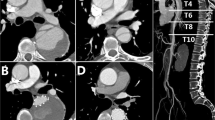Summary
BACKGROUND: Aortic dissections type B, rupture and aneurysms of the descending thoracic aorta carry the risk of life-threatening complications. But also surgical intervention in these pathologies is associated with significant morbidity and mortality. Aortic stent grafting is a novel important tool in the therapeutic armamentarium of these diseases. METHODS: 47 patients underwent 48 times replacement of the descending thoracic aorta. 81% were male, the mean age being 45 (16–75) years. The diagnosis was aortic dissection (31%), degenerative aneurysm (10%), posttraumatic aneurysm/rupture (44%), and others (15%). RESULTS: 50% of the operations were acute cases and 17% were reoperations. The length of ICU stay was 6 (1–37) days. There was no case of postoperative paraplegia. The hospital mortality was 14.6%. From preoperative patient-related variables, operations performed as acute cases were significantly associated with hospital mortality (p = 0.047), whereas age, sex and aortic dissection were not. Survival rates were 76% after 1 year, 70% after 5 and 70% after 10 years. CONCLUSIONS: At our hospital the first-line therapy for symptomatic acute or chronic aortic dissections type B and for high-risk patients with degenerative aneurysms is aortic stent grafting. In low-risk patients with descending aortic aneurysm, patients with traumatic aortic rupture (with no contraindication for surgery using extracorporeal circulation), and patients where stent grafting is not applicable or not successful, surgical treatment is an option with good long-term results.
Zusammenfassung
GRUNDLAGEN: Aortendissektionen Typ B nach Stanford, Ruptur und Aneurysmen der thorakalen Aorta descendens sind lebensbedrohliche Krankheiten. Aber auch die chirurgische Therapie dieser Erkrankungen ist mit einer deutlichen Morbidität und Mortalität verbunden. Aorten-Stentgrafts stellen eine in den letzten Jahren zunehmende Behandlungsalternative dar. METHODIK: An 47 Patienten wurden 48 thorakale Aorta- descendens-Ersätze durchgeführt. 81 % der Patienten waren männlich und das Alter betrug 45 (16–75) Jahre. Die Diagnosen waren Aortendissektion (31 %), degenerative Aneurysmen (10 %), posttraumatische Aneurysmen/Rupturen (44 %), und andere (15 %). ERGEBNISSE: 50 % waren Akut-Operationen und 17 % Reoperationen. Die Intensivaufenthaltsdauer betrug 6 (1–37) Tage. Kein Patient hatte eine postoperative Paraplegie. Die Hospitalmortalität betrug 14,6 %. Von den präoperativen Variablen war nur die Akutoperation signifikant mit der Hospitalmortalität assoziiert (p = 0,047), wohingegen Alter, Geschlecht und Aortendissektion nicht signifikant waren. Die Überlebensraten betrugen 76 % nach 1 Jahr, 70 % nach 5 und 70 % nach 10 Jahren. SCHLUSSFOLGERUNGEN: An unserer Klinik werden symptomatische akute oder chronische Aortendissektionen Typ B und Hochrisiko-Patienten mit degenerativen Aneurysmen in erster Linie mit Aorten-Stentgrafts versorgt. Bei Niedrigrisiko-Patienten mit Aorta-descendens-Aneurysmen, Patienten mit traumatischer Aortenruptur (bei denen keine Kontraindikation für eine Operation mit extrakorporaler Zirkulation besteht) und Patienten, bei denen Stentgrafts nicht anwendbar sind oder nicht erfolgreich durchgeführt wurden, stellt die operative Sanierung eine Behandlungsoption mit guten Langzeitergebnissen dar.
Similar content being viewed by others
Author information
Authors and Affiliations
Corresponding author
Rights and permissions
About this article
Cite this article
Schachner, T., Bonatti, J., Laufer, G. et al. Aneurysms, rupture and dissection of the descending thoracic aorta: surgical results and treatment strategies. Eur Surg 36, 157–160 (2004). https://doi.org/10.1007/s10353-004-0073-8
Issue Date:
DOI: https://doi.org/10.1007/s10353-004-0073-8




